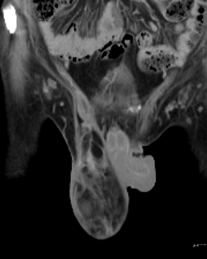病例報告-陰囊脂肪肉瘤
朱信誠、劉家宏
台北醫學大學-部立雙和醫院泌尿科
Case report- Spermatic cord liposarcoma
Hsin-Cheng Chu, Chia-Hung Liu
Department of Urology, Taipei Medical University-Shuang Ho Hospital, Taipei, Taiwan
Backgroud:
Liposarcoma of the spermatic cord is a rare disease and often mistakenly diagnosed as inguinal hernia, hydrocele, and lipoma.
Case Report:
A 66-year-old man presented to the outpatient department with an twelve-month history of a painless right-sided scrotal swelling mass which was non-tender and non-movable. An ultrasound scan carried out at the time had suggested an inguinal hernia to be the cause. Clinically, however, the swelling was not typical of an inguinal hernia so an CT scan was performed (Figure 1). The findings were interpreted as an inguinal hernia containing omentum protruding into the scrotum. There was no suspicion of malignancy to be the cause at the time.
The patient went on to have elective surgery as part of his treatment. During surgery, multilobulated lipomatous mass was found, that was separate from the right spermatic cord. The size of the mass was 115 x 60 x 32 mm, and this was primarily excised and sent to the pathology laboratory. Prolene mesh was used for posterior wall enhancement. Histology revealed typical of a well-differentiated liposarcoma, with clear margins. The patient was discharged. However, the patient was brought to ER for right scrotal pain on post-operative day six. Body temperature was 37.7 C, but no toxic sign such as malaise, or chills. CT scan was conducted, and showed right scrotal hematoma formation. Right radical orchiectomy was performed as elective surgery. Operative finding include 400ml of dark reddish hematoma and right scrotal liposarcoma. Previous mesh was also removed. The patient was discharged under stable condition.
Conclusion:
Liposarcoma of the spermatic cord is a rare disease especially with long-term scrotum lipoma. The diagnosis is difficult but important. Imaging examinations should be necessary, if there is any possibility of malignancy. Radical surgery of high orchiectomy with wide resection of the tumor is necessary for long-term disease free survival.

|
Figure1. A heterogenous mass at right scrotu |